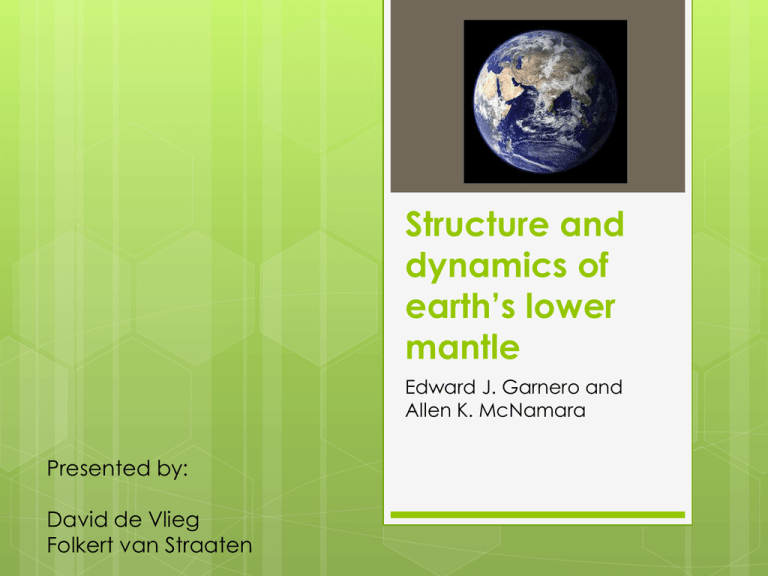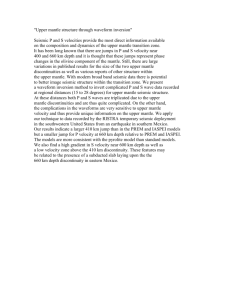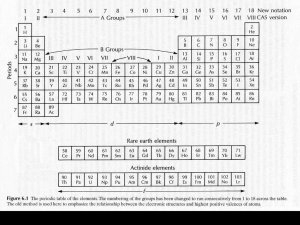Document
advertisement

Structure and dynamics of earth’s lower mantle Edward J. Garnero and Allen K. McNamara Presented by: David de Vlieg Folkert van Straaten Research on lower most mantle: This part of the mantle has influence on the convection and chemistry of the entire mantle It plays an important role in the heat release of the core It has influence on thermal structure and evolution of the earth Key scientific areas to study the lower mantle Seismology Mineral physics Geodynamics Geochemistry to get a better insight into the lower mantle, it is important to combine these areas Different theories to explain the lower mantle anomalies Anomalies are caused by a Temperature effect Chemical effect It is very difficult to determine how important each effect is and how they influence each other During the remainder of the presentation we focus on the different theories explaining the properties of the lower mantle Historical perspective lower most mantle research Discovery of a reduced seismic velocity gradient as function of depth This was interpreted as a lower most mantle thermal boundary layer above a hot core 1980’s: seismologists also observed a first order discontinous increase in velocity between 250 km and 350 km above the core-mantle boundary (CMB) This was named the D” discontinuity Anomalies in shear velocity Lower shear velocity Higher shear velocity The D” discontinuity D’’discontinuity does not have a specific structural characteristic, but is more a general depth shell of a few hundred kilometers It shows a connection with subduction and Hot spot regions above it This can be used as an argument for total mantle convection Convergent plate boundaries overlie D″ regions with higher than average velocities hot-spot volcanoes overlie D″ regions with lower than average velocities. combined with evidence for high P- and S-wave velocities mimicking subduction slab shapes The LLSVP’s (large low-shearvelocity province’s) Below Africa and the Pacific regions two broad regions of lower shear velocity and higher than average density are observed African region is ca. 15000 km across and 1000 km high Pacific region is ca. 15000 km across and 500 km high Both show sharp edges with normal mantle What are these LLSVP’s? No agreement Geodynamical view: Higher density material will go to upwelling regions by convection LLSVP’s have stable densities Too low density will cause buoyancy Too high density will flat out or even let the structures disappear Other way to look at LLSVP’s Thermochemical view: LLSVP’s are in essence superplumes in different stadia, and due to a thermochemical balance very stable thermochemical superplumes may heat up and rise because of excess thermal buoyancy then cool and sink due to decreased thermal buoyancy Smaller plumes with the denser material can form at the top of these structures Mantle Piles Mantle piles are piles with specific chemical properties They are accumulated in the Pacific and African region, which are dominant upwelling centers Piles are passively swept and shaped by mantle convection Plumes maybe originate from pile tops, in particular at peaks and ridges Causes of this lower-mantle chemical heterogeneity Lower mantle heterogeneity could be explained by: remnants of primordial material the result of chemical reaction products from the CMB remnants of subducted oceanic material A way to recognise the chemical properties of a pile Piles composed of a long-lived primordial layer will likely have sharp contacts at their top surface Piles composed of accumulated subducted material may have a rough or diffusive top Chemistry of llsvp’s Volcanic hot spots tend to overlie LLSVP edges rather than their interiors consistent with edges and ridges of thermochemical piles forming in regions of return flow and initiating plumes This is still controversial Because numerical models of mantle convection show that plume morphologies are often more complicated than simple vertically continuous whole-mantle conduits Further geochemical research on ocean island basalts (OIB’s) is necessary Cause of D” discontinuity Lateral variations in deep-mantle temperature are expected but should be smooth hence they do not explain a step velocity increase D″ has interpreted as chemical dregs from subduction, as a region of chemical reaction between the core and mantle, Today most preferred: as a boundary between isotropic and anisotropic fabrics, or as a solid-state phase change D” discontinuity and chemical properties of LLSVP”s (1) D’’-discountinuity could be the result of the transition from perovskite into post-perovskite This transitions has a positive Clapeyron curve So when temperature increases the pressure needed for the transition must be higher Double crossing Perovskite, PostPerovskite From: Ferroir D” discontinuity and chemical properties of LLSVP”s (2) Due to this positive Clapeyron relation the discontinuity should deepen or even vanish in hot area’s Near the core double crossing This is not the case: Clear evidence is present for an S-wave discontinuity within the Pacific LLSVP Proof for a different chemical composition! (maybe higher iron content) D” discontinuity and chemical properties of LLSVP”s (3) Perovskite to Post perovskite: exothermic reaction Resulting in Plume formation Higher convection leads to lower temperatures Lower temperatures reaction D” discontinuity and chemical properties of LLSVP”s (4) To determine which of the possibilities is the most probable you need to measure the discontinuities perfectly Measuring anisotropy using horizontal and vertical components of shear waves is a way to do this Anisotropy and measuring the D’’ discontinuity (1) If the D’’ anisotropy is the result of the change from perovskite into post perovskite an offset of depth between the onset of the anomaly and the discontinuity is expected This is because the preferred lattice orientation is only visible after a sufficient amount of deformation Anisotropy and measuring the D’’ discontinuity (2) may explain seismic observations under the central Atlantic which thought to be away from current downwellings which there is evidence for a D″ discontinuity but a weak seismic anisotropy Ultra-low velocity zones (1) Directly above the CMB 5 to 40 km thick thin patches in which Pand S-wave velocities are reduced by up to 10% and 30%, respectively Partial 10% melt and a density increase up to Ultra-low velocity zones (2) These ULVZ’s can be used to say something about LLSVP’s: If the most lower mantle has an isochemical composition ULVZ’s should be the thickest in the middle of a LLSVP (hottest region) If a LLSVP has a thermochemical structure the hottest regions should be at their edges and ULVZ’s should be the thickest here Ultra-low velocity zones (3) Most proof that llsvp’s have a thermochemical structure instead of a isochemical structure Thank you for listening Are there still questions?








